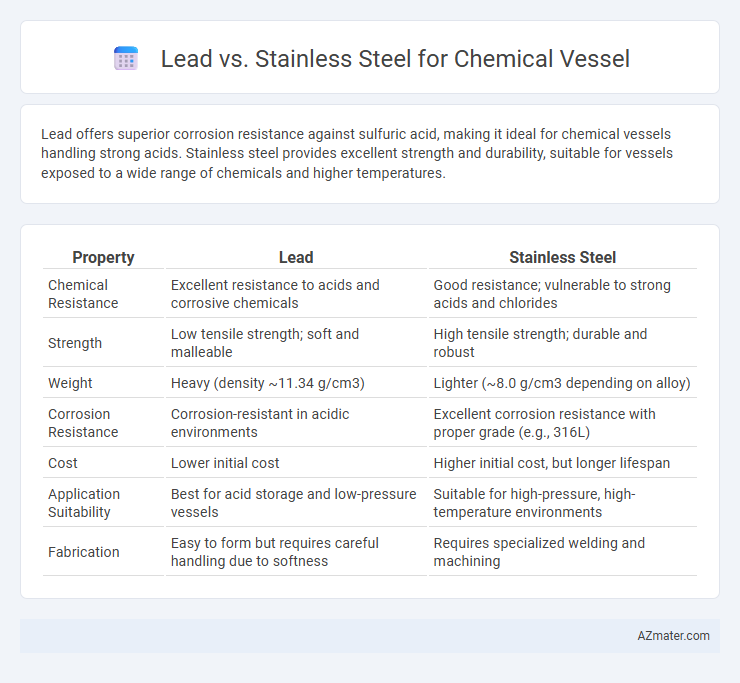Lead offers superior corrosion resistance against sulfuric acid, making it ideal for chemical vessels handling strong acids. Stainless steel provides excellent strength and durability, suitable for vessels exposed to a wide range of chemicals and higher temperatures.
Table of Comparison
| Property | Lead | Stainless Steel |
|---|---|---|
| Chemical Resistance | Excellent resistance to acids and corrosive chemicals | Good resistance; vulnerable to strong acids and chlorides |
| Strength | Low tensile strength; soft and malleable | High tensile strength; durable and robust |
| Weight | Heavy (density ~11.34 g/cm3) | Lighter (~8.0 g/cm3 depending on alloy) |
| Corrosion Resistance | Corrosion-resistant in acidic environments | Excellent corrosion resistance with proper grade (e.g., 316L) |
| Cost | Lower initial cost | Higher initial cost, but longer lifespan |
| Application Suitability | Best for acid storage and low-pressure vessels | Suitable for high-pressure, high-temperature environments |
| Fabrication | Easy to form but requires careful handling due to softness | Requires specialized welding and machining |
Introduction to Chemical Vessel Materials
Chemical vessels primarily require materials that offer excellent corrosion resistance and durability under aggressive chemical environments. Lead is favored for its superior resistance to strong acids like sulfuric acid, making it suitable for specific chemical storage applications. Stainless steel, especially grades like 316L, provides robust mechanical strength and broad chemical resistance, often preferred for high-pressure and temperature conditions in various industrial processes.
Overview of Lead and Stainless Steel
Lead offers exceptional corrosion resistance and is highly effective in handling strong acids, making it ideal for chemical vessels exposed to highly aggressive environments. Stainless steel, particularly grades like 304 and 316, provides superior mechanical strength, durability, and resistance to a broad range of chemicals, including mild acids and alkalis, while also maintaining structural integrity at elevated temperatures. Choosing between lead and stainless steel depends on factors such as chemical compatibility, mechanical stress, temperature conditions, and cost considerations for chemical vessel applications.
Chemical Compatibility and Corrosion Resistance
Lead offers excellent chemical compatibility with strong acids like sulfuric and nitric acid due to its inert surface, making it highly resistant to corrosion in highly acidic environments. Stainless steel, specifically grades like 316L, provides robust corrosion resistance against a wide range of chemicals including caustics and organic solvents but can be prone to pitting and stress corrosion cracking in strong chlorides and oxidizing acids. Selecting between lead and stainless steel depends on the specific chemical agents involved and temperature conditions, as lead excels in highly acidic, low-temperature applications while stainless steel is preferred for broader chemical exposure and higher mechanical strength.
Mechanical Strength and Durability
Lead offers excellent corrosion resistance against strong acids and chemicals but has low mechanical strength and poor durability under stress, limiting its use to lining or coating applications in chemical vessels. Stainless steel, particularly grades like 316L, provides superior mechanical strength and long-term durability, making it suitable for structural components exposed to mechanical loads and harsh chemical environments. Combining stainless steel's robustness with lead's chemical resistance is a common practice to optimize vessel longevity and performance.
Safety and Toxicity Concerns
Lead offers excellent corrosion resistance in acidic environments but poses significant toxicity risks due to its heavy metal properties, requiring stringent handling and disposal protocols. Stainless steel, specifically grades like 316L, provides robust chemical resistance while ensuring structural integrity without the inherent health hazards associated with lead exposure. Selecting stainless steel over lead for chemical vessels minimizes safety concerns related to metal leaching and environmental contamination, supporting safer operational environments in industrial applications.
Cost Comparison and Economic Considerations
Lead offers a lower initial cost compared to stainless steel for chemical vessels, making it an attractive option for budgets constrained by upfront expenditure. However, stainless steel provides superior durability, corrosion resistance, and a longer lifespan, which can reduce maintenance and replacement expenses over time. Evaluating total cost of ownership--including factors like chemical compatibility, operational conditions, and lifecycle expenses--is crucial for making an economically sound choice between lead and stainless steel vessels.
Maintenance and Longevity
Lead offers excellent corrosion resistance in highly acidic environments, reducing maintenance frequency for chemical vessels exposed to strong acids. Stainless steel provides superior mechanical strength and durability, with a longer lifespan in less aggressive chemical settings but may require regular inspection to prevent pitting and crevice corrosion. Choosing lead or stainless steel depends on the specific chemical exposure and maintenance capacity, impacting the overall longevity and operational costs of the vessel.
Regulatory and Environmental Compliance
Lead vessels offer excellent corrosion resistance but face stringent regulatory restrictions due to lead's toxic properties and environmental hazards, limiting their use in chemical processing. Stainless steel is widely favored for chemical vessels because it complies with stringent environmental and safety regulations, including REACH and EPA standards, due to its non-toxic nature and recyclability. Regulatory compliance often mandates the use of stainless steel in industries handling hazardous or food-grade chemicals to minimize environmental impact and ensure worker safety.
Application Suitability in Industry
Lead offers exceptional corrosion resistance against strong acids like sulfuric and hydrochloric acid, making it ideal for chemical vessels handling highly acidic environments in industries such as battery manufacturing and chemical processing. Stainless steel provides superior strength, durability, and resistance to a broader range of chemicals, including alkalis and chlorides, making it suitable for pharmaceutical, food processing, and petrochemical applications requiring both mechanical integrity and hygienic conditions. Selection depends on the chemical compatibility, operating temperature, and mechanical stress requirements specific to the industrial process.
Final Recommendations and Conclusion
Lead offers superior corrosion resistance in highly acidic environments, making it ideal for sulfuric acid storage, while stainless steel provides enhanced mechanical strength and durability for general chemical processing. Selecting the appropriate material depends on factors such as chemical concentration, temperature, and pressure conditions in the vessel operation. For long-term performance and safety, stainless steel is recommended for versatility and structural integrity, whereas lead remains the best choice for highly corrosive, low-stress applications.

Infographic: Lead vs Stainless Steel for Chemical Vessel
 azmater.com
azmater.com